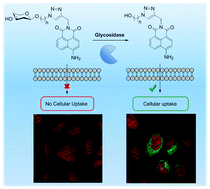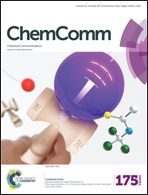Glycosidase activated release of fluorescent 1,8-naphthalimide probes for tumor cell imaging from glycosylated ‘pro-probes’†
Abstract
Glycosylated 4-amino-1,8-naphthalimide derivatives possess a native glycosidic linkage that can be selectively hydrolysed in situ by glycosidase enzymes to release the naphthalimide as a fluorescent imaging or therapeutic agent. In vitro studies using a variety of cancer cell lines demonstrated that the naphthalimides only get taken up into cells upon enzymatic cleavage from the glycan unit; a mechanism that offers a novel approach for the targeted delivery of probes/drugs.

- This article is part of the themed collection: Host–guest chemistry


 Please wait while we load your content...
Please wait while we load your content...